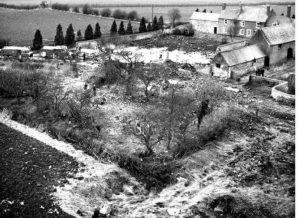The reason for adding this page, is that I witnessed this accident, when I was just 11. The aircraft flew over our school, clearly in trouble and later in the distance a dark mushroom cloud emerged. It had crashed on Cow Close Farm, where my uncle and his family lived. Most recently, Fiona Eayrs my cousin, reminded about this article and thought it prudent to publish it.
The story of XM604 incident was published by the Leicester Mercury on 30 Jan 2018. Article by Alan Thompson
 Memories will turn to a remote corner of Rutland today where 50 years ago a Cold War bomber on a training mission plummeted to earth, killing four of its six crew.
Memories will turn to a remote corner of Rutland today where 50 years ago a Cold War bomber on a training mission plummeted to earth, killing four of its six crew.
Vulcan XM604 – part of Britain’s nuclear deterrent – took off from RAF Cottesmore on the morning of January 30, 1968.
The Vulcan fell out of a clear, blue sky and plunged back to earth 50 minutes later on to Cow Close Farm, between Exton and Burley.
The charred field (pictured) marks the spot where the bomber crashed, killing four of its six crew, leaving just two survivors.
One of them, the plane’s pilot, Flt Lt Peter Tait, broke a decades-long silence to speak publicly for the first time about his remarkable escape to the Leicester Mercury in October, 2007, a couple of months before the crash’s 40th anniversary.
Things began to go badly wrong shortly after take-off on what should have been a routine training exercise.
An aircraft heating system in the bomb bay, designed to protect sensitive equipment from the intense cold at 40,000ft, overheated.
A decision was made to abandon the mission, but the aircraft had to burn off several tonnes of fuel.
Peter flew the aircraft low over the airfield before commencing a climb to embark on a second approach.
Peter says there was a “very loud explosion followed by an extremely severe vibration” when they were less than 200ft from the ground.
The accident investigation reports reveal that a turbine disc, spinning at 25,000 revolutions per minute, had become separated from the engine, severing the controls to the rear of the plane.
The Vulcan had only two ejection seats, each located in the cockpit. The rest of the crew relied on parachutes.
The top of the cockpit exploded away from the plane as co-pilot Mike Gillett bailed out.
Peter, flying without a roof now, tried desperately to stabilise the plane so his crew could continue to try to escape.
Amazingly, Peter’s ejection seat parachute – which had not fully deployed – had hit and wrapped around overhead powerlines. The cables had short-circuited and fused the parachute to them.
The lines of the parachute stopped him like a bungee rope.
“I was very smartly retarded from 200 miles an hour to nothing. I just released the harness and walked away. My feet touched the ground as lightly as if I was stepping off the last step of a stair.”
Among those who witnessed the build up to the tragedy was retired Leicestershire police officer Phil “Mac” McDonald, now 69.
Then a 19-year-old leading aircraftsman based “on the line” with the Vulcan squadron at Cottesmore, he said: “I remember the aircraft coming across the airfield above the runway at about 100 feet, possible less, it was a beautiful sight in flight.
“It came across and went off the western side towards Melton. It banked around as though to go out of sight and then started dropping. It must have been a couple of miles away because I lost view of it.”
Mr McDonald, who now lives in Yorkshire, added: “We were quickly aware it had gone down and a lot of us were sent to the scene to collect or identify pieces of the aircraft near to where it went down.
“I picked up a wrist, I had only just turned 19, I hadn’t been involved with anything like this before. I think I just dropped it again, it was just a bit of a shock. It didn’t have any lasting effects, you just get on with your job.”